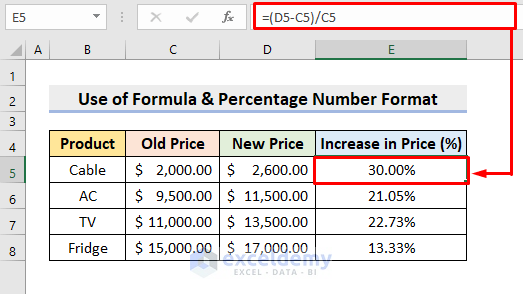Master Excel: How to Calculate Percentage Easily

Mastering Excel, especially in calculating percentages, can significantly enhance your data analysis capabilities. Whether you're involved in financial analysis, preparing statistical reports, or simply need to compute growth rates, percentages are a common requirement in spreadsheets. This guide will walk you through how to calculate percentages in Microsoft Excel with ease, ensuring you get the most out of this powerful tool.
The Basics of Percentages

Percentages are essentially parts per hundred. To calculate a percentage, you can use the formula: Percentage = (part / whole) * 100. Here's how to apply this in Excel:
Calculating Simple Percentages

- Select a cell: Choose the cell where you want the percentage to appear.
- Input the formula: Type
= (Part/Total) * 100where "Part" and "Total" are the respective cell references. - Format the cell: Once your formula is entered, right-click the cell, select 'Format Cells', choose 'Percentage', and specify the decimal places you need.
📝 Note: Excel will automatically format the result as a percentage if the cell is set to percentage format.
Example

If cell A1 has a value of 50 and cell B1 has a value of 150, to calculate what percentage 50 is of 150, you would:
- Type
=A1/B1*100in another cell, say C1. - Format C1 as a percentage with two decimal places.
Calculating Percentage Increase or Decrease

When tracking changes over time, you often need to calculate the percentage change. Here’s the formula: Percentage Change = (New Value - Old Value) / Old Value * 100
Step-by-Step Guide

- Identify Old and New Values: Let's say cell A1 holds the old value (e.g., 100) and cell B1 the new value (e.g., 120).
- Set up the formula: In cell C1, enter
=(B1-A1)/A1*100to find the percentage increase or decrease. - Apply Percentage Format: Format C1 as a percentage with no decimal places to show whole numbers.
📝 Note: If the result is negative, it indicates a decrease; positive indicates an increase.
Using Functions to Calculate Percentage

Excel has functions that can help with percentage calculations:
- PERCENTILE: To find a specified percentile in a range of numbers.
- PERCENTRANK: To determine the rank of a value as a percentage of a data set.
Example with PERCENTRANK
If you want to know the percentile rank of a student's score within a class:
- Your student's score is in cell A1, and all class scores are in cells A2:A20.
- In another cell (e.g., B1), type
=PERCENTRANK(A2:A20, A1)to get the percentile rank.
Advanced Calculations with Percentages

Calculating a Total with Given Percentage

If you have a known percentage and need to find the total from which it was calculated:
- Given a percentage in cell A1 (e.g., 30%) and the known part in cell B1 (e.g., 60).
- In cell C1, type
=B1 / (A1/100)to find the total.
Making Percentage Calculations Dynamic

To dynamically update percentage calculations as your data changes:
- Use named ranges or cell references within your formulas to make updates automatic.
Common Pitfalls and Best Practices

Watch Out for Rounding Errors

When formatting cells as percentages, be aware of rounding errors:
- Always check the underlying numerical values before relying on the percentage display.
Data Validation and Error Checking

- Conditional Formatting: Use it to highlight incorrect data entries.
- Error Checking: Employ Excel’s error checking tools to catch calculation errors.
Calculating percentages in Excel not only simplifies your data analysis but also provides a means to understand and present information in a more accessible way. Whether you're dealing with financial data, sales figures, or academic scores, Excel's versatile tools for percentage calculation ensure you can manage and interpret your data with precision.
What if my percentage comes out to more than 100%?

+
If your percentage calculation results in over 100%, it means the part is greater than the whole, indicating an increase or that the part has exceeded the original total. This often happens when calculating growth rates or when dealing with cumulative data.
Can I format a cell to show fractions instead of percentages?
+Yes, you can format cells to display values as fractions. Right-click the cell, select 'Format Cells', then under the 'Number' tab, choose 'Fraction'. This allows you to present data as parts of a whole in a different format.
How can I convert percentages back to their decimal equivalent in Excel?
+Simply divide the percentage cell by 100. If cell A1 contains a percentage (e.g., 30%), type =A1/100 to get the decimal equivalent (e.g., 0.30).
What are some practical applications of percentage calculations in Excel?
+Percentage calculations are invaluable in:
- Financial analysis for calculating ROI, profit margins, and growth rates.
- Statistical analysis to compare parts of a dataset to the whole.
- Academic grading systems to convert marks into grades.
- Inventory management for tracking stock levels as a percentage of total inventory.
How can I make my percentage calculations automatically update when my data changes?
+To ensure your percentage calculations update dynamically with changes to your data:
- Use relative or absolute cell references in your formulas based on your needs.
- Implement named ranges for frequently used data sets.
- Utilize data tables or Excel tables for structured data management, allowing Excel to adjust references automatically when you add or remove data.
As you deepen your understanding of Excel’s percentage calculations, you’ll find it becomes second nature to perform these operations efficiently. Whether for professional reporting, academic purposes, or personal finance management, Excel’s capabilities for calculating and formatting percentages can elevate your data handling to the next level.



